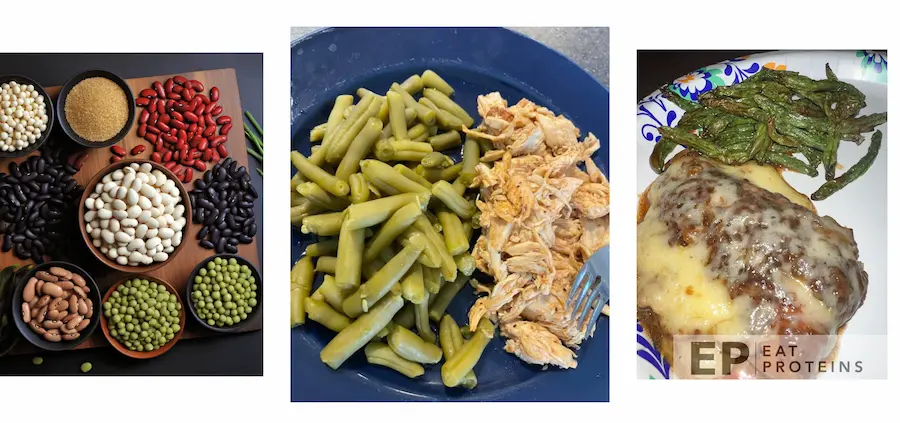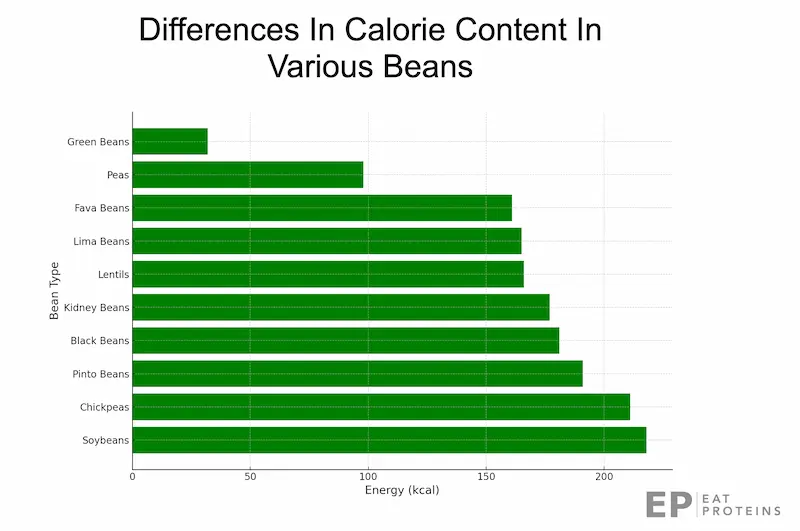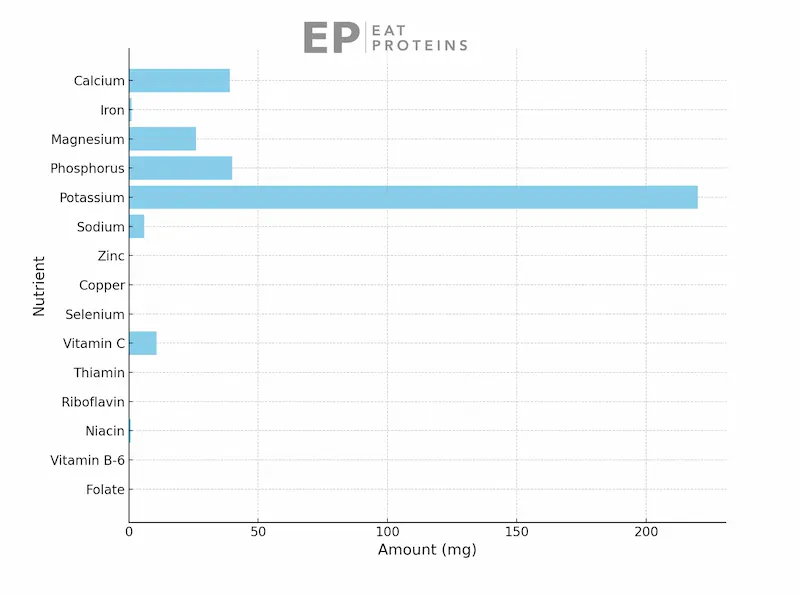
Yes, you can have beans on the Optavia 5 and 1 plan, but only certain types. Specifically, you can enjoy green beans and wax beans. However, you cannot have black beans, kidney beans, or pinto beans.
This is because these types of beans have higher calorie content, which could affect your weight loss journey on the Optavia program, as shown in this diagram.

Interestingly, this advice seems contrary to some scientific research on beans and weight loss. For instance, a 2020 study by Larry A. Tucker from Brigham Young University, titled “Bean Consumption Accounts for Differences in Body Fat and Waist Circumference,” highlights the potential benefits of beans for weight management.
In this study, 246 women were examined, and the researchers found an inverse relationship between bean intake and body fat percentage. Women who consumed moderate or high amounts of beans had less body fat and smaller waists than those with low intakes. These associations remained significant even after adjusting for potential confounders.
Beans and other legumes possess several nutritional qualities that reduce the risk of many diseases. However, the relationship between legume intake and obesity isn’t straightforward. From Tucker’s research, it seems that beans could be beneficial in combating obesity.
As a result, many questions arise regarding the next steps after completing the Optavia 5 and 1 plan, such as whether beans can be consumed on the Optavia 3 and 3 plan and what other foods are permitted on the program.
What Type Of Beans Can You Eat On Optavia 5 and 1?
On the Optavia 5 and 1 program, you can enjoy half a cup of green beans and half a cup of wax beans per serving. Green beans are like nature’s multivitamin.
You’ve got a decent amount of Vitamin C in there, about 10.8 milligrams. That’s important for your immune system, skin health, and so much more.
Green beans also serve up a good amount of Potassium (220 milligrams), Magnesium (26 milligrams), and Phosphorus (40 milligrams), as shown in the bar chart below.

Potassium is great for your heart health and blood pressure, while Magnesium is involved in hundreds of biochemical reactions in your body, and Phosphorus helps your body make protein and use carbs and fats.
According to the U.S. Department of Agriculture, green beans have around 31 calories per 100 grams. When it comes to ounces, you’re looking at approximately 8.79 calories per ounce (based on 31 calories per 100 grams).
A serving of half a cup will give you around 61.75 calories (assuming that half a cup weighs around 7.04 ounces). If you prefer a whole cup, that would be approximately 123.5 calories (assuming one cup weighs around 14.08 ounces).
Other beans allowed on Optavia 5 and 1 diet are wax beans, also called yellow beans. Just like green beans, yellow beans are mostly made up of water – about 88.8% to be exact. They’re a little bit higher in energy, at 50 kcal compared to green beans’ 32 kcal. This is mainly due to their higher fat content, which is around 2.71 grams.
When it comes to vitamins and minerals, yellow beans still pack a punch, but there are a few differences compared to green beans, as shown in this graph.

They have less Vitamin C, about 3.4 milligrams, but that’s still a good amount for boosting your immune system and keeping your skin healthy.
Yellow beans also contain a good amount of Potassium (122 milligrams), Magnesium (23 milligrams), and Phosphorus (30 milligrams), just like green beans. But they have a bit more Sodium, around 130 milligrams. This is something to watch out for if you’re trying to reduce your salt intake.
What Type Of Beans Are Not Allowed On Optavia 5 and 1?
This list shows the types of beans that are not allowed on the Optavia 5 and 1 plan.
- Black beans
- Kidney beans
- Pinto beans
- Lima beans
- Fava beans
- Soybeans
- Chickpeas
- Lentils
- Peas
1. Black beans
You can have various types of beans on the Optavia plan, but one type of bean that you cannot have is black beans. According to the U.S. Department of Agriculture, every 100 grams of black beans serve you around 181 kcal of energy, 8.23 grams of protein, 7.01 grams of fat, and 22 grams of carbs. That’s probably why Optavia advises against them.
In every ounce of black beans, you’ll get roughly 6.34 kcal of energy, 0.29 grams of protein, 0.25 grams of fat, and 0.77 grams of carbs. As per cup, black beans have around 311.32 kcal of energy, 14.16 grams of protein, 12.06 grams of fat, and 37.84 grams of carbs.
2. Kidney Beans
On Optavia 5 and 1 plan, it is advised to avoid kidney beans. Based on a serving size of 100 grams, kidney beans contain about 62.2 grams of water and provide approximately 177 kcal of energy. In terms of protein, they offer around 8.06 grams.
The total lipid (fat) content is about 6.97 grams, while the carbohydrate content is approximately 21.2 grams. These beans are a good source of dietary fiber, with around 6.9 grams per serving. In terms of sugar, kidney beans have a low content, with approximately 0.3 grams.
3. Pinto Beans
You cannot have pinto beans on Optavia 5 and 1 plan. Pinto beans contain 58.5 grams of water, providing 191 calories of energy per serving size of 100 grams (equivalent to 3.5 ounces or 0.44 cups).
They also offer 8.37 grams of protein, 7.11 grams of total lipid (fat), and 24.4 grams of carbohydrates. Additionally, pinto beans are a good source of dietary fiber, with 8.4 grams per serving. The sugar content is relatively low at 0.32 grams.
4. Lima Beans
Although lima beans offer valuable nutrients, they are not recommended on the Optavia 5 and 1 plan due to their nutritional composition. In a 100-gram serving of lima beans, you can find 64.9 grams of water, 165 calories for energy, 7.25 grams of protein, 6.86 grams of total fat, 19.4 grams of carbohydrates, 6.5 grams of dietary fiber, and 2.7 grams of sugar.
Additionally, lima beans contain various minerals: 16 milligrams of calcium, 2.23 milligrams of iron, 40 milligrams of magnesium, 103 milligrams of phosphorus, 472 milligrams of potassium, and 218 milligrams of sodium.
5. Fava Beans
On the Optavia 5 and 1 plan, there are certain beans that you should avoid, such as fava beans. The nutritional composition of fava beans in a serving size of 100 grams (approximately 3.5 ounces) includes 66.5 grams of water, 161 calories of energy, 7.06 grams of protein, 6.88 grams of total lipid (fat), 18.3 grams of carbohydrates, 5 grams of dietary fiber, and 1.69 grams of sugars.
In terms of minerals, fava beans provide approximately 34 mg of calcium, 1.4 mg of iron, 40 mg of magnesium, 116 mg of phosphorus, 249 mg of potassium, 220 mg of sodium, 0.94 mg of zinc, and 0.241 mg of copper.
6. Soybeans
You cannot eat soybeans on the Optavia 5 and 1 plan. Soybeans have a serving size of 100 grams. In this serving, they contain 218 calories, 16.9 grams of protein, 14.8 grams of total fat, and 7.77 grams of carbohydrates.
If we look at the nutritional facts, soybeans also provide 5.6 grams of dietary fiber, 2.79 grams of sugars, 95 milligrams of calcium, 4.79 milligrams of iron, 80 milligrams of magnesium, 228 milligrams of phosphorus, 479 milligrams of potassium, 217 milligrams of sodium, 1.07 milligrams of zinc, 0.378 milligrams of copper, 6.8 micrograms of selenium, and 1.5 milligrams of vitamin C.
7. Chickpeas
Chickpeas, also known as garbanzo beans, are not allowed on the Optavia 5 and 1 plan. Although chickpeas are a good source of protein, with 8.23 grams per serving, they also contain 211 calories of energy per 3.5 ounces serving.
In terms of fat content, they contain 8.91 grams of total lipid. The carbohydrate content is 25.5 grams, including 7.1 grams of dietary fiber and 4.46 grams of sugar.
In terms of minerals, chickpeas offer 46 milligrams of calcium, 2.7 milligrams of iron, 45 milligrams of magnesium, 156 milligrams of phosphorus, and 270 milligrams of potassium. They also contain 222 milligrams of sodium, 1.42 milligrams of zinc, 0.327 milligrams of copper, and 3.4 micrograms of selenium.
8. Lentils
On the Optavia 5 and 1 plan, lentils are not allowed due to their calorie composition. For a serving size of 100 grams, lentils contain 166 calories, 8.38 grams of protein, 6.86 grams of fat, and 18.7 grams of carbohydrates.
Lentils have 1.67 grams of sugar and provide various minerals such as 18 milligrams of calcium, 3.11 milligrams of iron, 33 milligrams of magnesium, 167 milligrams of phosphorus, and 343 milligrams of potassium. However, they are relatively higher in sodium, with 218 milligrams per serving.
9. Peas
Peas are not Optavia-friendly becasue of their high-calorie content. A serving size of 100 grams of peas contains 77.3 grams of water and provides approximately 98 kcal of energy. They offer about 4.99 grams of protein, 2.81 grams of total lipid (fat), and 13.8 grams of carbohydrates.
Within the carbohydrate content, there are 4.4 grams of dietary fiber and 4.26 grams of total sugars, including NLEA. Peas also provide some essential minerals, such as 24 milligrams of calcium, 1.47 milligrams of iron, 21 milligrams of magnesium, and 75 milligrams of phosphorus.
What Types of Foods Are Allowed on Optavia 5 and 1?
If you’re looking for the Optavia diet food list, here are the foods you can enjoy: lean meats, fish and seafood, eggs, dairy products, lower-carb veggies (1 cup serving size), medium and high-carb veggies (1/2 cup serving size), Vegetarian options, healthy fats, frozen meals, optional snacks, and selected condiments.
This graph shows the approved food choices on the Optavia diet plan.

Can You Eat Beans on Optavia 3 and 3?
Yes, you can eat all types of beans on the Optavia 3 and 3 plan. The 3 and 3 plan is more flexible than the 5 and 1 plan, allowing for higher calories and a wider variety of food groups. This means that foods that are higher in calories, like beans, can be included in your meals.

